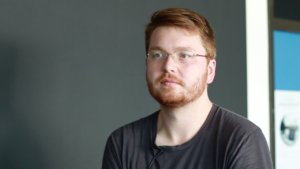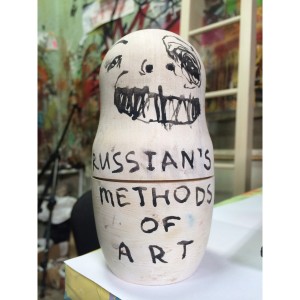M: So the first project took place in Vienna, 1993. According to an invitation of the Secession. And in
this time somebody claimed, that art could actually cause an effect in society. Not only on a
symbolic level. Not only illustrating problems, but actually solving concrete problems. In this time
there were many homeless people on the Wiener Karlsplatz and after a close research the group
had discovered, that the biggest problem or one of the problems one could take care of was the
bad medical care of the homeless. Not because they had officially been excluded from the medical
care system, but because they had been disposed by doctors with flimsy excuses: they should
shower before going to a doctor. That’s how the idea occurred to do something about it. If it’s not
possible for homeless people to get a medical provision, the medical provision has to get to the
homeless. And the idea was, to arrange a mobile medical provision for homeless people. This is a
small bus, which is constructed as a medical station. With a medical staff, which takes care of
medical care and a funding body – in this case it was the Caritas – and a sponsorship – private
sponsors, but also the city Vienna.
M: Also das erste Projekt hat 1993 in Wien statt gefunden. Auf Einladung der Sezession. Und damals
war es so, dass die Behauptung aufgestellt wurde, dass Kunst durchaus konkret in einer Gesellschaft
etwas bewirken kann. Nicht nur auf einer symbolischen Ebene, nicht nur indem man Probleme
darstellt, sondern indem man konkrete Probleme löst. Angeboten hat sich zu dem damaligen
Zeitpunkt ein Problem, das direkt vor den Türen dieser Institution, die die WochenKlausur eingeladen
hatte, war. Auf dem Wiener Karlsplatz gab es zu dem Zeitpunkt damals sehr viele Obdachlose und
nach einer eingehenden Recherche hat die Gruppe damals festgestellt, dass das größte Problem
oder eins der Probleme, der man sich annehmen kann, in der Situation war, dass die Obdachlosen
eine schlechte medizinische Versorgung bekommen haben. Nicht weil sie offiziell aus dem
Krankensystem ausgeschlossen wären, sondern informell sind sie oft weggeschickt worden von
Ärzten mit fadenscheinigen Begründungen häufig. Sie sollten sich vorher duschen gehen bevor sie
zum Arzt gehen. Deshalb war die Idee, dass man da was macht. Wenn es Obdachlosen nicht
möglich ist, medizinische Versorgung zu bekommen, muss die medizinische Versorgung zu den
Obdachlosen hinkommen. Und die Idee war, eine mobile medizinische Versorgung für Obdachlose
einzurichten. Das ist ein kleiner Bus, der eingerichtet ist als eine medizinische Station. Dazu gehört
ein medizinisches Personal, das sich um die Vorsorgen kümmert und eine Trägerschaft – in dem Fall
war das die Karitas – und Geldgeber – einerseits private Sponsoren, andererseits aber auch die Stadt
Wien. es ist nicht der Bus als materielle Ausformung, der das Werk ist. Es ist die Tatsache, dass eine
Lösung geschaffen werden konnte. Das ist das Werk.
M: It is not the bus as a material implementation which is the artwork. It is the fact, that a solution
was created. This is the artwork!
M: Es ist nicht der Bus als materielle Ausformung, der das Werk ist. Es ist die Tatsache, dass eine
Lösung geschaffen werden konnte. Das ist das Werk!
H: This was also quite funny in the project in Kassel. We exhibited this pink garden hutch to create a
location where people can meet and where a problem can be discussed. And the pink garden hutch
worked as an artwork for the institution. So we could say: it’s something that looks like art. And in the
same time it was not an artwork from our point of view. So it had this double function, it was very
fitting to all sides, when everybody asked: And where is the art now? And we did not even have to
say: there is something big and pink over there! It was accepted and taken for granted by itself. So in
Kassel we were invited by the protestant church, because there was a problem with a lot of drug
addicts on a square that belonged to the protestant church and where a protestant church was
placed. And this dilemma occurred between being understandable and not wanting to send anyone
away but having the feeling on the other hand, that the people, who wanted to visit the church
could not visit it any longer, because there were so many drug addicts occupying it.
H: Das war auch ganz lustig in dem Projekt in Kassel. Da haben wir eben diese pinke Gartenhaus
ausgestellt, um auch einen Ort zu schaffen wo sich Leute treffen können und wo ein Problem
besprochen wird. Und das pinke Gartenhaus hat einerseits funktioniert für die Institution als
Kunstwerk. Also wir konnten dann sagen: Es ist irgendetwas, das so ausschaut wie Kunst. Und
gleichzeitig war es nicht das, was wir als Kunst sehen. Also das hat diese doppelte Funktion gehabt,
dass es auf der Seiten sehr praktisch war, dass alle gefragt haben: Und wo ist jetzt die Kunst? Und
wir mussten nicht einmal sagen: Da steht eh etwas pinkes Großes da! Das hat man dann einfach
auch so akzeptiert und angenommen. In Kassel sind wir eingeladen worden von der Evangelischen
Kirche, weil es da ein Problem gab mit sehr vielen Drogensüchtigen oder Suchtkranken auf einem
Platz, der der Evangelischen Kirche gehört hat wo auch eine Evangelische Kirche situiert war. Und
gleichzeitig hat sich da so ein Dilemma entsponnen zwischen, auf der Seiten verstehen und auch
niemanden wegschicken wollen, auf der anderen Seite das Gefühl haben, das die Menschen, die die
Kirche besuchen nicht mehr die Kirche besuchen können, weil da so viele Suchtkranke diesen Platz
okkupieren.
M: Our proposal for solution, which we eventually realized was, that we have established two social
worker-locations, which have been funded by the city and the church together. They have started to
work with all the participants and conflict parties, to make acceptance from both sides possible.
M: Der Lösungsvorschlag, den wir dazu dann umgesetzt haben war, dass wir zwei Sozialarbeiter-
Stellen geschaffen haben, die von Stadt und Kirche gemeinsam finanziert worden sind. Die haben
dann an diesem Platz mit allen Beteiligten und allen Konfliktparteien begonnen haben zu arbeiten,
um eine gegenseitige Akzeptanz zu schaffen.

















